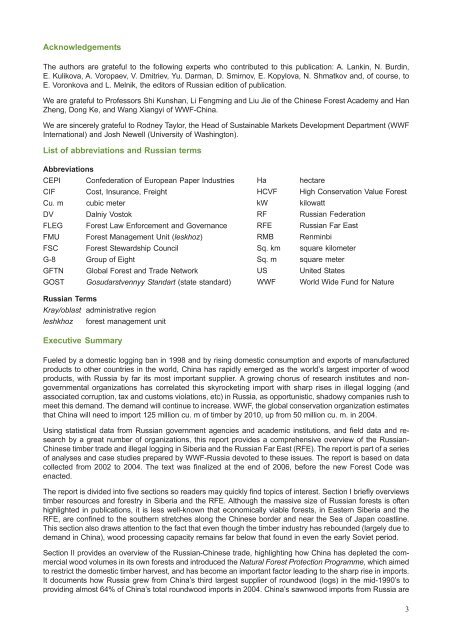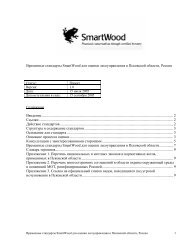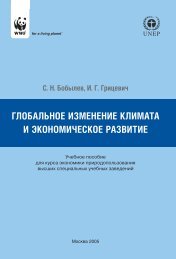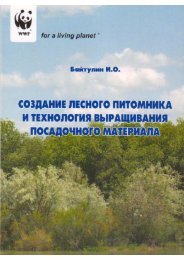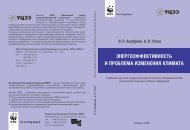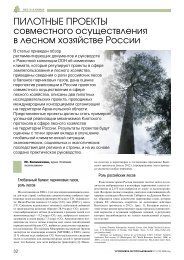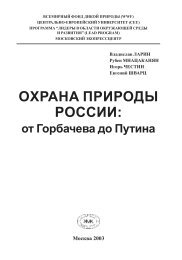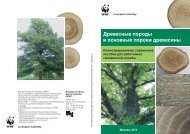AcknowledgementsThe authors are grateful to the following experts who contributed to this publication: A. Lankin, N. Burdin,E. Kulikova, A. Voropaev, V. Dmitriev, Yu. Darman, D. Smirnov, E. Kopylova, N. Shmatkov and, of course, toE. Voronkova and L. Melnik, the editors of <strong>Russia</strong>n edition of publication.We are grateful to Professors Shi Kunshan, Li Fengming and Liu Jie of the Chinese Forest Academy and HanZheng, Dong Ke, and Wang Xiangyi of WWF-<strong>China</strong>.We are sincerely grateful to Rodney Taylor, the Head of Sustainable Markets Development Department (WWFInternational) and Josh Newell (University of Washington).List of abbreviations and <strong>Russia</strong>n termsAbbreviationsCEPI Confederation of European Paper IndustriesCIF Cost, Insurance, FreightCu. m cubic meterDV Dalniy VostokFLEG Forest Law Enforcement and GovernanceFMU Forest Management Unit (leskhoz)FSC Forest Stewardship CouncilG-8 Group of EightGFTN Global Forest and <strong>Trade</strong> NetworkGOST Gosudarstvennyy Standart (state standard)<strong>Russia</strong>n TermsKray/oblast administrative regionleshkhoz forest management unitExecutive SummaryHaHCVFkWRFRFERMBSq. kmSq. mUSWWFhectareHigh Conservation Value Forestkilowatt<strong>Russia</strong>n Federation<strong>Russia</strong>n Far EastRenminbisquare kilometersquare meterUnited StatesWorld Wide Fund for NatureFueled by a domestic logging ban in 1998 and by rising domestic consumption and exports of manufacturedproducts to other countries in the world, <strong>China</strong> has rapidly emerged as the world’s largest importer of woodproducts, with <strong>Russia</strong> by far its most important supplier. A growing chorus of research institutes and nongovernmentalorganizations has correlated this skyrocketing import with sharp rises in illegal logging (andassociated corruption, tax and customs violations, etc) in <strong>Russia</strong>, as opportunistic, shadowy companies rush tomeet this demand. The demand will continue to increase. WWF, the global conservation organization estimatesthat <strong>China</strong> will need to import 125 million cu. m of timber by 2010, up from 50 million cu. m. in 2004.Using statistical data from <strong>Russia</strong>n government agencies and academic institutions, and field data and researchby a great number of organizations, this report provides a comprehensive overview of the <strong>Russia</strong>n-Chinese timber trade and illegal logging in Siberia and the <strong>Russia</strong>n Far East (RFE). The report is part of a seriesof analyses and case studies prepared by WWF-<strong>Russia</strong> devoted to these issues. The report is based on datacollected from 2002 to 2004. The text was finalized at the end of 2006, before the new Forest Code wasenacted.The report is divided into five sections so readers may quickly find topics of interest. Section I briefly overviewstimber resources and forestry in Siberia and the RFE. Although the massive size of <strong>Russia</strong>n forests is oftenhighlighted in publications, it is less well-known that economically viable forests, in Eastern Siberia and theRFE, are confined to the southern stretches along the Chinese border and near the Sea of Japan coastline.This section also draws attention to the fact that even though the timber industry has rebounded (largely due todemand in <strong>China</strong>), wood processing capacity remains far below that found in even the early Soviet period.Section II provides an overview of the <strong>Russia</strong>n-Chinese trade, highlighting how <strong>China</strong> has depleted the commercialwood volumes in its own forests and introduced the Natural Forest Protection Programme, which aimedto restrict the domestic timber harvest, and has become an important factor leading to the sharp rise in imports.It documents how <strong>Russia</strong> grew from <strong>China</strong>’s third largest supplier of roundwood (logs) in the mid-1990’s toproviding almost 64% of <strong>China</strong>’s total roundwood imports in 2004. <strong>China</strong>’s sawnwood imports from <strong>Russia</strong> are3
also rising rapidly, from 4.3% of total sawnwood imports in 2000 to 11.3% in 2004. However, <strong>Russia</strong> remainsprimarily a roundwood exporter to <strong>China</strong>, with 87% of the roundwood in the form of coniferous logs. Two majordrivers are behind the emergence of <strong>Russia</strong> as <strong>China</strong>’s most important wood supply source: price and thesimilarity of species used. The section also highlights the major exporting regions to <strong>China</strong>. Seven administrativeregions — Krasnoyarskiy, Irkutskaya, Buryatia, Chintinskaya, Amurskaya, Khabarovskiy, and Primorskiy —made up 90% of total <strong>Russia</strong>n export in 2004. More than 80% of this goes by rail by ship (14.6%) and truck(1.6%). Finally, this section discusses the explosion in the number of both exporters and importers involved inthe trade. Nevertheless, the report also points out that the top twenty roundwood exporters make up 25% of thetotal export, while the top five importers account for 18% of total imports. This provides evidence that there aresome dominant players in the industry and provides hope that if these key actors improve their selling andpurchasing practices that illegal logging and trade can be reduced. The section concludes by profiling some ofthe largest exporters and importers, with flow charts of their respective wood supply chains.Section III overviews how <strong>Russia</strong>n timber is distributed in <strong>China</strong>. This includes where it is processed, whatproducts are made from it, and where these products are consumed. The report identifies and describes firstlevel,second-level, and third-level timber markets. These markets play a central role in the import of the timberand its distribution to other parts of <strong>China</strong>. The first-level markets are major processing centers, mainly forsawnwood, while second-level markets, such as Dalian, in addition to processing of sawnwood also producesolid-wood furniture and flooring. Most of the coniferous timber is used in the domestic construction industryand for interior decoration. In contrast, hardwood timber is used primarily to produce solid-wood furniture andflooring, much of it for export. Chinese companies are quickly expanding operations to seize upon these rapidlygrowing export industries and <strong>Russia</strong>n hardwood is essential in providing the raw material necessary to do so.Third-level timber markets, meanwhile, are small-scale retail markets scattered throughout the country andfocus on providing customized, semi-processed products for local consumers. These markets are particularlyprevalent in small- and medium-sized cities, as many builders in rural areas still use wood for doors and windowframes.Section IV, the largest section in the report, focuses on illegal logging and trade in Eastern Siberia and the RFE.Illegal logging in <strong>Russia</strong> results in direct losses of over US$1 billion annually and it is particularly pronounced inexport-dependent administrative regions such as those that border <strong>China</strong>. The underlying causes for illegallogging and trade in <strong>Russia</strong> are multifaceted and complex, but many stem from weak state control over thesector. The report elaborates on how imperfect legislation and forest policy, poor enforcement, and inadequatewood processing contribute to illegality. The section documents the extent of illegal logging in High ConservationValue Forests (HCVFs) in the southern RFE and its ecological, social, and economic impacts. The sectionalso describes the two prevalent timber chain models (commercial harvester ® importer; and harvester ®intermediary ® importer) and what aspects of these models allow for the infiltration of illegally logged timber intothe chains and make them susceptible to graft and corruption. Finally, the section discusses what politicalmeasures and industry initiatives are underway to address illegality in the sector.Section V provides concrete measures that industry and government should undertake to address both illegallogging and trade and rising demand for wood in <strong>China</strong>. Due to the interdependent nature of these problems,many of the suggested measures recommend collaborative efforts between the relevant <strong>Russia</strong>n and Chineseactors. The recommendations can be summarised as follows:Government and aid agencies should improve forest sector governance in Eastern <strong>Russia</strong>; <strong>Russia</strong>n producers should demonstrate a commitment to responsible forestry by joining the Association ofEnvironmentally Responsible <strong>Timber</strong> Producers of <strong>Russia</strong>, which is the association member of the GlobalForest and <strong>Trade</strong> Network, and by adopting systems to verify the legality and/or sustainability of their operations; End-users of Chinese manufactured products (in Europe, North America, Japan and elsewhere) shouldadopt and implement policies to ensure the wood in those products is responsibly sourced; Companies manufacturing or sourcing wood and paper products in <strong>China</strong> should ensure they come fromlegal and sustainable sources; The <strong>Russia</strong>n and Chinese Governments should enhance bilateral cooperation to combat illegal trade byenforcing forest legislation, strengthening inter-agency cooperation in both countries, and promote legalityverification of timber product export and import.4


